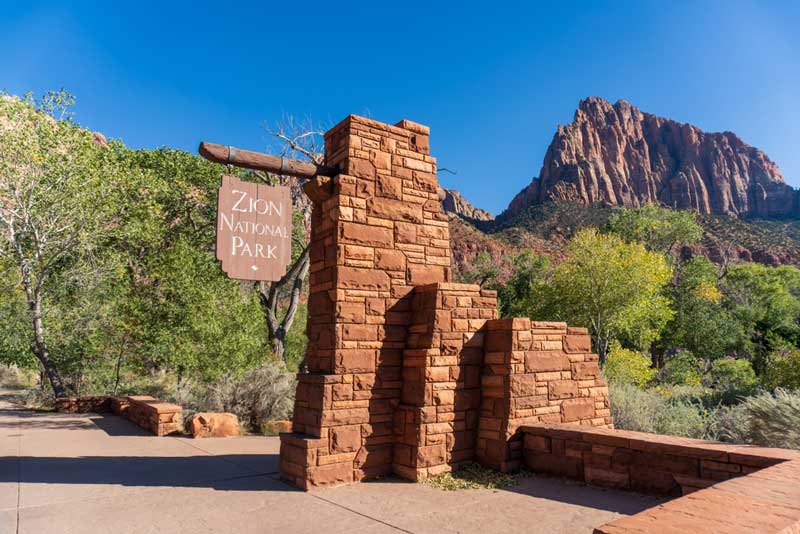Zion National Park stands as one of America’s most breathtaking natural wonders, Nestled in the heart of southwestern Utah, drawing over 4.3 million visitors annually to experience its towering red sandstone cliffs, emerald pools, and narrow slot canyons. Established as Utah’s first national park in 1919, Zion spans 229 square miles of diverse ecosystems, from desert floors to high plateaus, creating a landscape that has inspired countless adventurers, photographers, and nature enthusiasts for over a century. The park’s name, derived from the Hebrew word meaning “sanctuary” or “refuge,” perfectly captures the spiritual and restorative experience that awaits visitors within its boundaries.
Located just 43 miles northeast of St. George and 158 miles from Las Vegas, Zion National Park offers incredible accessibility for travelers exploring the American Southwest. The park’s proximity to major cities makes it an ideal destination for both weekend getaways and extended Utah road trips, while its location along the scenic Zion-Mount Carmel Highway provides stunning drives through diverse terrain. Whether you’re flying into McCarran International Airport in Las Vegas or driving from Salt Lake City, Zion serves as the perfect gateway to Utah’s “Big Five” national parks and the greater Colorado Plateau region.
What makes Zion truly special is its unique combination of accessibility and adventure, offering activities for every type of traveler. From family-friendly riverside walks to heart-pounding technical canyoneering routes, the park provides endless opportunities to connect with nature while challenging yourself in one of the most beautiful settings on Earth. The park’s well-maintained trail system, comprehensive shuttle service, and year-round accessibility ensure that visitors can create unforgettable memories regardless of their experience level or the season they choose to visit.
Things to Do in Zion National Park, Utah
1. Conquer the Legendary Angels Landing Trail
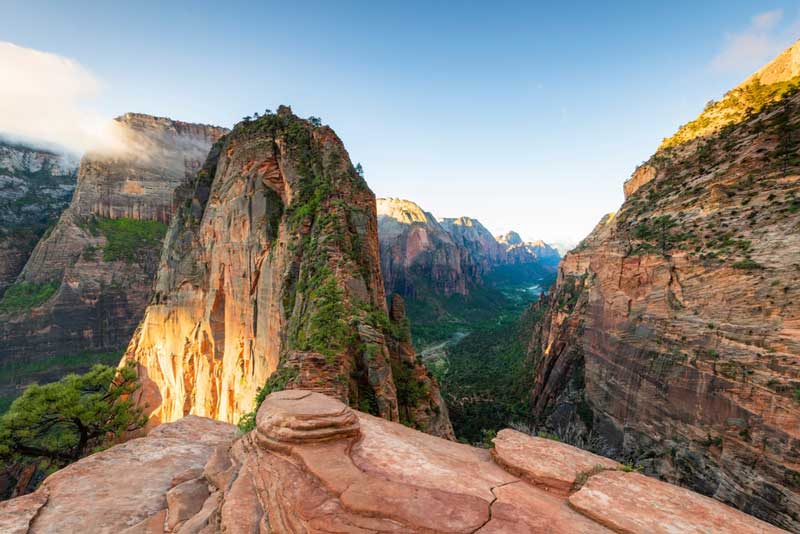
Angels Landing
Angels Landing stands as Zion’s most famous and challenging day hike, offering one of the most rewarding and adrenaline-pumping experiences in any national park. This 5.4-mile round-trip trek begins at the Grotto shuttle stop and climbs 1,488 feet through diverse terrain, culminating in a narrow rock fin that provides 360-degree views of Zion Canyon. The trail’s final half-mile requires hikers to navigate chains bolted into the rock face while traversing narrow ledges with dramatic drop-offs on both sides, making it one of the most thrilling things to do in Zion National Park.
The journey to Angels Landing begins with a pleasant walk along the Virgin River before ascending through a series of switchbacks known as Walter’s Wiggles. These 21 short, steep switchbacks were engineered in the 1920s and represent one of the most ingenious trail construction projects in national park history. After conquering Walter’s Wiggles, hikers reach Scout Lookout, which offers spectacular views and serves as a turnaround point for those not comfortable with the final chains section.
Important Note: As of 2022, Angels Landing requires timed permits for all hikers, which can be obtained through recreation.gov. Permits are required year-round and must be purchased in advance through both seasonal and day-before lotteries. The trail is typically accessible from late spring through early fall, though winter conditions can make the chain’s section extremely dangerous due to ice and snow.
2. Wade Through The Narrows Slot Canyon
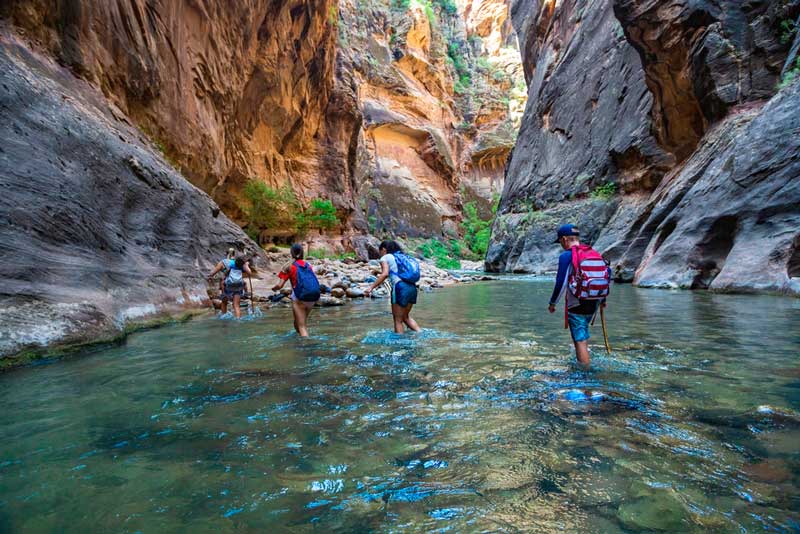
The Narrows
The Narrows represents one of the most unique hiking experiences in the United States, taking adventurers through the Virgin River as it winds between towering canyon walls that soar up to 1,000 feet overhead.
This slot canyon hike can be experienced as either a bottom-up day hike starting from the Temple of Sinawava or as a full-day top-down adventure requiring advanced planning and permits. The river hike offers an otherworldly experience as sunlight filters through the narrow opening above, creating dramatic lighting effects on the sculpted sandstone walls.
For most visitors, the bottom-up approach provides the perfect introduction to The Narrows, allowing hikers to wade upstream as far as they feel comfortable before turning back. The first mile takes you through the paved Riverside Walk before entering the river itself, where the canyon walls gradually narrow and the experience becomes increasingly spectacular.
Popular turnaround points include the junction with Orderville Canyon and the famous “Wall Street” section, where the canyon narrows to just 20 feet wide.
Essential Tips: Proper footwear is crucial for this hike – consider renting canyoneering shoes, dry suits, and walking sticks from outfitters in Springdale. The Narrows is best experienced from late spring through early fall, as winter conditions can be dangerous due to cold water temperatures and flash flood risk. Always check weather conditions and flash flood potential before entering the river.
3. Explore the Emerald Pools Trail System
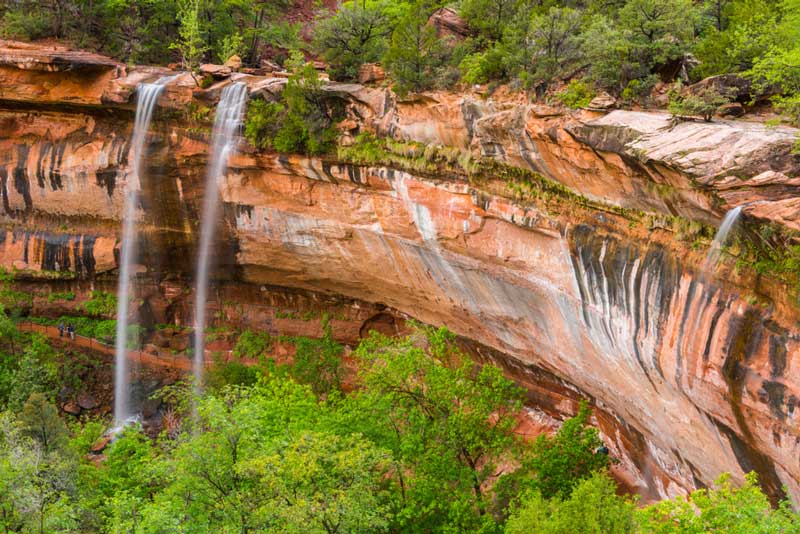
Emerald Pools
The Emerald Pools Trail system offers one of Zion’s most family-friendly hiking experiences, featuring three distinct pools connected by well-maintained trails that showcase the park’s diverse plant life and geological features. This network of trails provides options for hikers of all abilities, from the easy Lower Emerald Pool Trail to the more challenging Upper Emerald Pool route. The pools themselves are natural water features created by springs and seasonal waterfalls that cascade over hanging gardens of moss, ferns, and wildflowers.
The Lower Emerald Pool Trail, accessible from the Zion Lodge shuttle stop, features a paved pathway that leads to a shallow pool beneath a seasonal waterfall. This 1.3-mile round-trip walk is perfect for families with young children and offers opportunities to spot wildlife including mule deer, rock squirrels, and various bird species. The Middle Emerald Pool requires crossing a small stream and provides a more secluded experience, while the Upper Emerald Pool trail involves a steeper climb but rewards hikers with the largest and most pristine of the three pools.
Best Time to Visit: The pools are most impressive during spring snowmelt and after summer thunderstorms when waterfalls are at their peak flow. Early morning visits often provide the best lighting for photography and fewer crowds, especially during peak season from March through November.
4. Discover Hidden Canyon’s Secret Passages
Hidden Canyon Trail represents one of Zion’s most rewarding moderate hikes, offering a perfect balance of challenge and accessibility while leading to a spectacular hanging canyon that remains hidden from view until the final approach. This 3-mile round-trip adventure begins at the Weeping Rock shuttle stop and climbs 850 feet through a series of switchbacks before reaching the narrow entrance to Hidden Canyon. The trail features several sections with chains for assistance, though they’re not as exposed or challenging as those found on Angels Landing.
The journey to Hidden Canyon takes hikers through diverse ecosystems, from desert scrub vegetation at the trailhead to cooler, more lush environments as elevation increases. The final approach to the canyon involves a brief scramble through a narrow slot, opening into a hidden world of towering walls, natural arches, and seasonal pools. The canyon extends for nearly a mile beyond the main trail, offering opportunities for exploration and solitude for those willing to navigate the boulder-strewn canyon floor.
Trail Conditions: The Hidden Canyon Trail is typically accessible from late spring through early fall, though winter conditions can make the chain sections dangerous due to ice. The trail offers excellent photography opportunities throughout the day, with the canyon entrance providing dramatic lighting effects during late morning and early afternoon hours.
5. Reach New Heights at Observation Point
Observation Point Trail offers arguably the most spectacular panoramic views in Zion National Park, climbing 2,148 feet over 8 miles round-trip to reach a viewpoint that towers 2,000 feet above the canyon floor. This strenuous hike rewards determined adventurers with breathtaking 360-degree views of Zion Canyon, Angels Landing, and the surrounding wilderness areas. The trail begins at the Weeping Rock shuttle stop and immediately begins a series of steep switchbacks that test hikers’ endurance and determination.
The journey to Observation Point takes hikers through multiple ecosystems, from the desert floor through pinion and juniper woodlands to the cooler ponderosa pine forests near the rim. Along the way, the trail offers several viewpoints that provide increasingly spectacular perspectives of the canyon below. The final approach involves traversing a narrow ridge before reaching the main viewpoint, where visitors can look down upon Angels Landing and gain a true appreciation for the scale and grandeur of Zion’s landscape.
Important Considerations: This trail requires excellent physical fitness and should only be attempted by experienced hikers. The exposed nature of much of the trail makes it unsuitable for winter hiking, and summer attempts should begin before dawn to avoid dangerous afternoon heat. Always carry plenty of water, sun protection, and emergency supplies for this challenging adventure.
6. Experience Nature’s Shower at Weeping Rock
Weeping Rock Trail provides one of Zion’s most accessible and family-friendly hiking experiences, offering a short but rewarding walk to a unique geological feature that demonstrates the park’s complex water systems. This 0.4-mile round-trip trail climbs just 98 feet to reach a large alcove where water seeps through the porous Navajo sandstone, creating a natural “weeping” effect that supports hanging gardens of ferns, columbines, and other moisture-loving plants.
The trail itself is paved and well-maintained, making it suitable for visitors of all ages and abilities. Along the way, interpretive signs explain the geological processes that create Weeping Rock and the unique ecosystem it supports. The alcove provides a cool, shaded respite from the desert heat and offers excellent opportunities for photography, particularly during the golden hours of early morning and late afternoon when light filters through the water droplets.
Educational Value: Weeping Rock serves as an excellent introduction to Zion’s geology and hydrology, demonstrating how water shapes the landscape over thousands of years. The site is particularly impressive during spring when seasonal wildflowers bloom in the hanging gardens, creating a stunning contrast against the red sandstone backdrop.
7. Stroll the Riverside Walk to Temple of Sinawava
The Riverside Walk represents the perfect introduction to Zion’s natural wonders, offering a gentle 2.2-mile round-trip stroll along the Virgin River that showcases the park’s diverse ecosystems and serves as the gateway to The Narrows. This fully paved trail follows the river through a lush riparian environment where towering cottonwoods and box elders create a natural tunnel effect, providing shade and creating a dramatically different atmosphere from the surrounding desert landscape.
The walk terminates at the Temple of Sinawava, a natural amphitheater surrounded by towering canyon walls that create an almost cathedral-like atmosphere. This area serves as the official starting point for Narrows hikes but offers plenty of beauty and interest for those who prefer to keep their feet dry. The temple area provides excellent opportunities for wildlife viewing, with frequent sightings of mule deer, wild turkeys, and various bird species that thrive in the riparian environment.
Accessibility Features: The Riverside Walk is fully accessible to wheelchairs and strollers, making it one of the most inclusive experiences in the park. The trail offers numerous benches and rest areas, and interpretive signs provide information about the area’s natural and cultural history. The walk is particularly beautiful during fall when cottonwood trees display brilliant yellow foliage.
8. Capture Views from Canyon Overlook Trail
Canyon Overlook Trail offers one of Zion’s most rewarding short hikes, providing spectacular views of Zion Canyon and the town of Springdale from a unique eastern perspective. This 1-mile round-trip trail begins near the eastern entrance to the Zion-Mount Carmel Tunnel and climbs 163 feet through slickrock terrain to reach a dramatic overlook that showcases the park’s geological diversity. The trail provides an excellent introduction to Zion’s sandstone landscape while offering views that are completely different from those available from the main canyon floor.
The hike begins with a brief walk across slickrock formations before entering a narrow canyon that demonstrates the erosive power of water on sandstone. The trail then climbs steadily through a landscape of juniper and pinion pine, offering increasingly spectacular views as elevation increases. The final destination provides a perfect vantage point for photography, with Zion Canyon spread out below and the town of Springdale visible in the distance.
Photography Tips: The overlook offers excellent lighting conditions throughout the day, with particularly dramatic effects during sunrise and sunset. The eastern perspective provides unique views of formations like Angels Landing and the Great White Throne that cannot be seen from other viewpoints in the park. The trail is suitable for most fitness levels and can be completed in under an hour.
9. Hike to Scout Lookout for Panoramic Views
Scout Lookout serves as both a destination in itself and the halfway point for those continuing to Angels Landing, offering spectacular views of Zion Canyon without the exposure and technical challenges of the chains section. This 4-mile round-trip hike climbs 1,050 feet through diverse terrain, including the famous Walter’s Wiggles switchbacks, before reaching a spacious viewpoint that provides 270-degree views of the canyon below. For many visitors, Scout Lookout represents the perfect balance of challenge and reward when exploring what to do in Zion National Park.
The journey to Scout Lookout begins with a pleasant walk along the Virgin River before beginning the steady climb through a series of switchbacks that wind through different vegetation zones. The trail passes through cool, shaded areas where seeps and springs support lush vegetation, creating microclimates that provide relief from the desert heat. The final approach to Scout Lookout involves navigating the precisely engineered switchbacks that represent one of the most impressive trail construction achievements in national park history.
Visitor Information: Scout Lookout provides an excellent alternative for those who want to experience much of the Angels Landing hike without the technical challenges of the chains section. The viewpoint offers plenty of space for groups and provides excellent opportunities for rest and photography. No permits are required to hike to Scout Lookout, making it accessible to all visitors throughout the year.
10. Sunset Views from Watchman Trail
The Watchman Trail offers one of Zion’s most accessible moderate hikes, providing excellent views of Zion Canyon and the Virgin River valley from the southern end of the park. This 3.3-mile round-trip trail climbs 368 feet to reach a viewpoint on the lower slopes of the Watchman formation, offering unique perspectives of the park’s geology and the town of Springdale below. The trail is particularly popular for sunset viewing, as the western orientation provides unobstructed views of the evening light show on the canyon walls.
The hike begins near the visitor center and immediately begins climbing through typical high desert vegetation, including prickly pear cactus, yucca, and various shrub species. The trail offers interpretive opportunities to learn about desert ecology and the adaptations that allow plants and animals to thrive in this challenging environment. As elevation increases, views of the Virgin River valley expand, providing excellent photography opportunities throughout the hike.
Seasonal Considerations: The Watchman Trail is accessible year-round, though summer hikers should begin early to avoid afternoon heat. The trail is particularly beautiful during wildflower season in spring and offers excellent opportunities for wildlife viewing, including frequent sightings of canyon wrens, rock squirrels, and various lizard species. The viewpoint provides excellent sunrise and sunset photography opportunities.
11. Drive the Historic Zion-Mount Carmel Tunnel
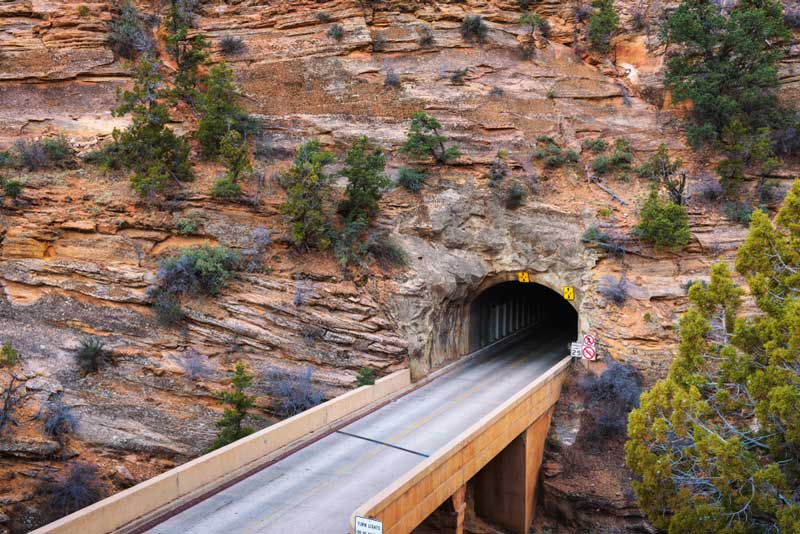
Zion Mount Carmel Tunnel
The Zion-Mount Carmel Tunnel represents one of the most impressive engineering achievements in national park history, offering visitors a unique way to experience the park’s geological diversity while traveling between different sections of Zion. Completed in 1930, this 1.1-mile tunnel was carved through solid sandstone and features six large windows that provide dramatic views of the canyon below. The tunnel connects the main Zion Canyon with the park’s eastern section, providing access to completely different landscapes and ecosystems.
The drive through the tunnel and along the Zion-Mount Carmel Highway offers constantly changing scenery, from the towering red cliffs of the main canyon to the white and cream-colored slickrock formations of the eastern section. The highway itself provides numerous pullouts and viewpoints where visitors can stop to photograph the changing landscape and explore short trails that lead to hidden arches and geological features. The eastern section of the park offers a completely different perspective on Zion’s geological story.
Driving Tips: Large vehicles including RVs and trailers require escort through the tunnel, which involves additional fees and potential wait times. The highway provides access to numerous short trails and viewpoints, making it an excellent half-day adventure for visitors wanting to see a different side of Zion. The drive is particularly spectacular during late afternoon when lighting conditions highlight the diverse rock formations.
12. Explore Kolob Canyons for Solitude
The Kolob Canyons section of Zion National Park offers a completely different experience from the main Zion Canyon, featuring dramatic finger canyons, colorful rock formations, and excellent opportunities for solitude and wildlife viewing. Located in the northwestern corner of the park and accessible via Interstate 15, this section provides a perfect half-day or full-day adventure for visitors looking to escape the crowds of the main canyon. The 5-mile Kolob Canyons Road provides access to numerous viewpoints and trailheads while showcasing some of the park’s most spectacular geological formations.
The Kolob Canyons visitor center provides excellent orientation to this section of the park, with exhibits explaining the geological processes that created the finger canyons and the unique ecosystems they support. The scenic drive offers numerous pullouts where visitors can photograph the dramatic red cliffs and learn about the area’s natural and cultural history. The section is particularly spectacular during fall when bigtooth maple trees display brilliant red and orange foliage, creating a stunning contrast against the red sandstone cliffs.
Trail Options: The Kolob Canyons section offers several excellent hiking opportunities, including the Taylor Creek Trail and the challenging Kolob Arch Trail. The area provides excellent opportunities for wildlife viewing, with frequent sightings of mule deer, wild turkeys, and various bird species. The section is typically less crowded than the main canyon, making it an excellent choice for visitors seeking solitude and quiet contemplation.
13. Bike the Pa’rus Trail
The Pa’rus Trail offers Zion’s only paved trail open to bicycles and pets, making it an ideal activity for families and visitors looking for a more relaxed way to experience the park’s beauty. This 3.5-mile round-trip trail follows the Virgin River from the South Campground to Canyon Junction Bridge, providing stunning views of the Watchman, West Temple, and Towers of the Virgin. The trail’s gentle grade and smooth surface make it accessible to visitors of all ages and abilities, including those using wheelchairs or strollers.
Canyon Junction Bridge serves as both a destination and a perfect viewpoint for photography, spanning the Virgin River where it meets the North Fork. The bridge area offers expansive views up the main canyon and provides excellent opportunities for sunrise and sunset photography. The Pa’rus Trail also connects to several other trailheads, making it a perfect warm-up walk before attempting more challenging hikes or a relaxing way to end a day of adventure.
Activity Tips: Bicycle rentals are available in Springdale, and the trail is particularly beautiful during early morning and late afternoon when lighting conditions are optimal. The trail remains open year-round and provides excellent wildlife viewing opportunities, especially for birds and small mammals that frequent the riverside environment.
14. Discover Wildlife Throughout the Park
Zion National Park supports an incredible diversity of wildlife, with over 289 bird species, 78 mammal species, and 44 reptile and amphibian species calling the park home. The park’s diverse ecosystems, from desert floors to high plateaus, create habitats that support everything from tiny hummingbirds to large mule deer. Wildlife viewing represents one of the most rewarding activities in Zion National Park, offering opportunities to observe animals in their natural habitats while learning about the complex relationships that sustain these desert ecosystems.
The Virgin River corridor provides some of the best wildlife viewing opportunities in the park, with lush riparian vegetation supporting numerous bird species including great blue herons, belted kingfishers, and various warbler species. Desert bighorn sheep can occasionally be spotted on the high cliffs, while mule deer are commonly seen throughout the park, especially during early morning and evening hours. The park’s diverse reptile population includes numerous lizard species, snakes, and the occasional desert tortoise.
Viewing Tips: Early morning and late afternoon provide the best opportunities for wildlife viewing, as many animals are most active during these cooler periods. The Riverside Walk, Pa’rus Trail, and areas around the visitor center offer excellent opportunities for bird watching. Always maintain appropriate distances from wildlife and never feed animals, as this can be dangerous for both visitors and animals.
15. Experience Zion’s Night Sky
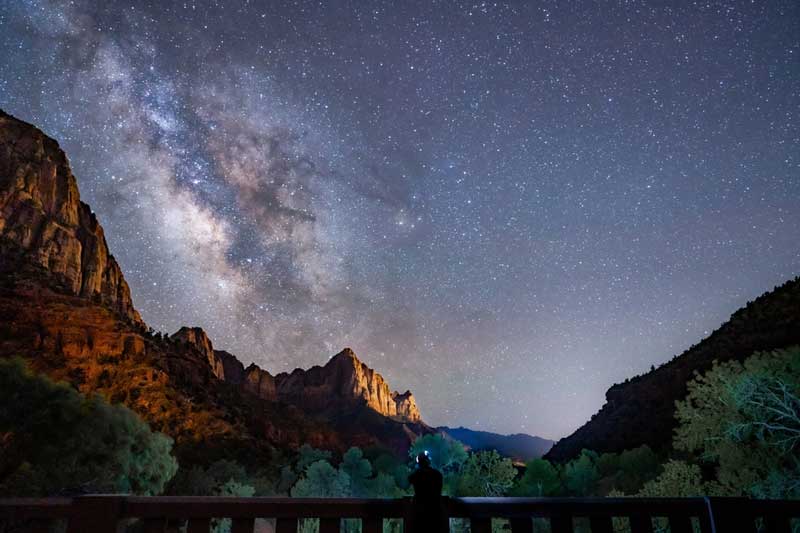
Zion National Park
Zion National Park offers some of the darkest skies in the continental United States, making it an exceptional destination for stargazing and night photography. The park’s remote location and minimal light pollution create conditions that allow visitors to observe thousands of stars, the Milky Way, and various celestial phenomena throughout the year. Night sky viewing represents one of the most peaceful and inspiring activities in Zion National Park, offering a completely different perspective on the park’s natural beauty.
The park regularly hosts astronomy programs led by park rangers and volunteer astronomers, providing telescopes and expert guidance for observing planets, star clusters, and other celestial objects. These programs typically take place at the visitor center amphitheater during new moon periods when sky conditions are optimal. The park’s high elevation and clear desert air create exceptional viewing conditions for both amateur and experienced astronomers.
Stargazing Tips: The best stargazing locations include the visitor center area, Pa’rus Trail, and areas away from the Zion Lodge. New moon periods provide the darkest skies, though the Milky Way is visible during most clear nights from spring through fall. Bring red flashlights to preserve night vision, and dress warmly as desert temperatures can drop significantly after sunset.
Local Travel Tips for Visiting Zion National Park
Getting There and Transportation: Zion National Park is easily accessible by car, with the main entrance located on State Route 9 near the town of Springdale. The park operates a free shuttle system from March through November that connects Springdale with the visitor center and major trailheads within the park. Private vehicles are restricted in the main canyon during shuttle season, making the shuttle system the primary transportation method for most visitors. The shuttle runs every 15-20 minutes and operates from early morning until late evening.
Where to Stay: Springdale offers numerous lodging options ranging from luxury resorts to budget-friendly motels, with many properties located within walking distance of the park entrance. The historic Zion Lodge, located within the park itself, provides a unique opportunity to stay inside the park boundaries but requires advance reservations, especially during peak season. For those seeking a more rustic experience, the park offers three campgrounds: South Campground, Watchman Campground, and Lava Point Campground, though reservations are strongly recommended.
Best Times to Visit: Zion National Park is accessible year-round, though each season offers different advantages. Spring (March-May) and fall (September-November) provide the most comfortable weather conditions and are ideal for hiking. Summer months can be extremely hot, with temperatures exceeding 100°F, making early morning and late afternoon the best times for outdoor activities. Winter offers mild temperatures and fewer crowds, though some high-elevation trails may be closed due to snow and ice conditions.
Nearby Towns and Services: Springdale serves as the gateway to Zion and offers restaurants, shops, equipment rental, and guided tour services. The town of Hurricane, located about 20 miles from the park, provides additional dining and lodging options. St. George, approximately 43 miles away, offers a full range of services including medical facilities, major shopping, and a regional airport. These towns provide excellent bases for exploring not only Zion but also nearby attractions like Bryce Canyon National Park and the North Rim of the Grand Canyon.
Are you planning a road trip to USA? Don’t miss our guide on things to do in Sharon Springs, things to do in Kenai and things to do in Abingdon for a fun time.
Frequently Asked Questions
How many days do you need to see Zion National Park?
Most visitors find that 2-3 days provides sufficient time to experience Zion’s major attractions, including Angels Landing, The Narrows, and the Emerald Pools. A long weekend allows time for 4-5 major hikes while still enjoying the park’s scenic drives and easier trails. However, outdoor enthusiasts and photographers often spend a week or more exploring the park’s extensive trail system and hidden gems in the Kolob Canyons section.
What is the best time of year to visit Zion National Park?�
Spring (March-May) and fall (September-November) offer the best weather conditions for hiking and outdoor activities, with comfortable temperatures and minimal rainfall. Summer can be extremely hot, with temperatures exceeding 100°F, though early morning and late afternoon activities remain enjoyable. Winter provides mild temperatures and fewer crowds, making it ideal for photography and easier hikes, though some high-elevation trails may be closed due to snow.
Do I need permits to hike in Zion National Park?�
Most trails in Zion National Park do not require permits, though some restrictions apply. Angels Landing requires timed permits year-round, which must be purchased in advance through recreation.gov. The top-down Narrows hike requires overnight permits, and all backcountry camping requires permits. Canyoneering activities also require permits. Day hiking on most trails, including the bottom-up Narrows hike, does not require permits.
Conclusion
Zion National Park offers an incredible diversity of activities and experiences that showcase the raw beauty and geological wonder of Utah’s red rock country. From the adrenaline-pumping Angels Landing chains to the peaceful Riverside Walk, the park provides something for every type of adventurer and nature lover.�
Whether you’re seeking challenging hikes, family-friendly activities, or simply a place to reconnect with nature, Zion’s 15 best activities offer unforgettable experiences that will leave you planning your return visit before you’ve even left the park.

